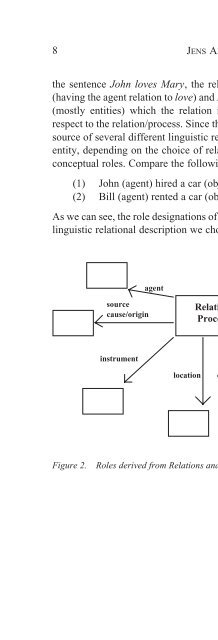Cognitive Semantics : Meaning and Cognition
Cognitive Semantics : Meaning and Cognition
Cognitive Semantics : Meaning and Cognition
Create successful ePaper yourself
Turn your PDF publications into a flip-book with our unique Google optimized e-Paper software.
SOME TENETS OF COGNITIVE SEMANTICS 25<br />
VI. Concepts show prototype effects (instead of following the Aristotelian<br />
paradigm based on necessary <strong>and</strong> sufficient conditions).<br />
The classical account of concepts within philosophy is Aristotle’s theory of<br />
necessary <strong>and</strong> sufficient conditions. However, one very often encounters<br />
problems when trying to apply the Aristotelian theory to concepts represented<br />
in natural language. As a result of a growing dissatisfaction with the classical<br />
theory of concepts, prototype theory was developed within cognitive psychology.<br />
6<br />
Within cognitive semantics, one attempts to account for prototype effects<br />
of concepts. A concept is often represented in the form of an image schema<br />
<strong>and</strong> such schemas can show variations just like concepts normally do. This<br />
kind of phenomenon is much more difficult to model using traditional symbolic<br />
structures.<br />
3. Fundamentals of a formal cognitive semantics<br />
Here, I will only outline the first steps in developing a cognitive semantics<br />
based on conceptual spaces. According to the cognitive view, semantics is a<br />
relation between language <strong>and</strong> a cognitive structure, <strong>and</strong> I submit here that the<br />
appropriate framework for the cognitive structure is a conceptual space. On<br />
this assumption, formulating a semantics for a specific language can be broken<br />
down into two major steps: (1) To specify the mapping between the lexicon of<br />
the language <strong>and</strong> the appropriate conceptual spaces. (2) To describe the<br />
operations on the image schemas (which are defined with the aid of the<br />
conceptual space) that correspond to different syntactic formation rules. In<br />
this section, I will discuss only the first step.<br />
Following the technical style of philosophical semantics, one can define<br />
an interpretation for a language L as a mapping of the components of L onto a<br />
conceptual space. As a first element of such a mapping, individual names are<br />
assigned vectors (i.e., points in the conceptual space) or partial vectors (i.e.,<br />
points with some arguments undetermined). In this way, each name (referring<br />
to an individual) is allocated a specific color, spatial position, weight, temperature,<br />
etc. Following Stalnaker (1981: 347), a function which maps the<br />
individuals onto a conceptual space will be called a location function.<br />
The fundamental lexical hypothesis is then the following: Predicates in















